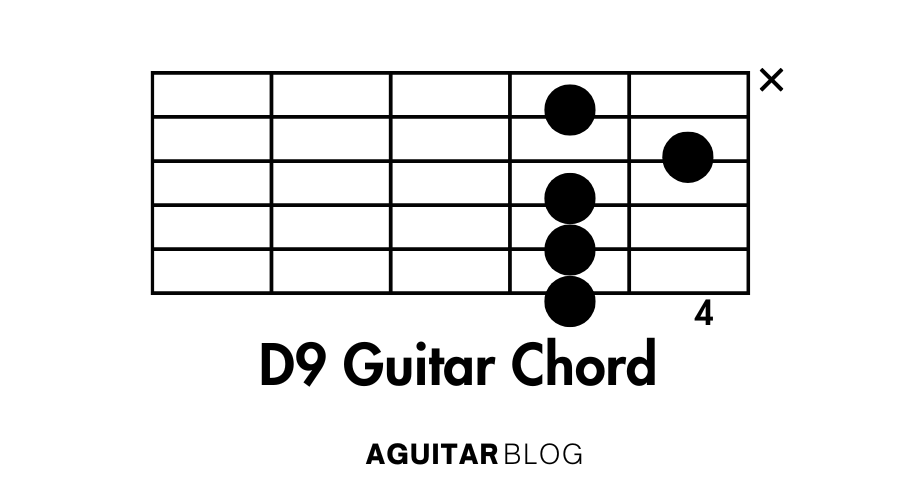The D9 guitar chord (D dominant 9) is a jazzy, vibrant chord that adds depth and color to any chord progression. It’s commonly used in blues, jazz, and funk, bringing a rich, soulful sound. In this guide, we’ll explore what the D9 chord is, how to play it, common mistakes to avoid, and practical tips for improving your chord transitions.
1. What is a D9 Guitar Chord?
The D9 chord is a dominant seventh chord with an added ninth. It consists of five notes: the root (D), the major third (F#), the perfect fifth (A), the minor seventh (C), and the major ninth (E). It adds a jazzy feel to dominant chords by incorporating the ninth note into the harmony.
D9 Chord Formula:
- Root (D)
- Major third (F#)
- Perfect fifth (A)
- Minor seventh (C)
- Major ninth (E)
The D9 chord adds a bright, slightly dissonant tone, making it great for jazz and funk music.
2. How to Play the D9 Guitar Chord

Here are two common ways to play the D9 chord on the guitar:
D9 Open Position:
- Place your index finger on the 1st fret of the B string (2nd string).
- Place your middle finger on the 2nd fret of the G string (3rd string).
- Place your ring finger on the 2nd fret of the high E string (1st string).
- Place your pinky finger on the 3rd fret of the D string (4th string).
- Strum from the A string down, letting the open A and D strings ring.
This open position gives a bright and spacious sound to the D9 chord.
D9 Barre Chord (5th Fret):
- Barre your index finger across the 5th fret, from the A string (5th string) to the high E string (1st string).
- Place your middle finger on the 6th fret of the G string (3rd string).
- Place your ring finger on the 7th fret of the D string (4th string).
- Place your pinky finger on the 7th fret of the B string (2nd string).
- Strum from the A string down (strum five strings).
This barre chord version provides a fuller and richer sound compared to the open position.
Strumming Tips:
- In both positions, focus on strumming the strings relevant to the chord. Avoid hitting the low E string, as it’s not part of the chord.
- Make sure each string rings clearly without any muted or buzzing notes.
3. Video Tutorial
For a visual walkthrough of how to play the D9 chord, check out this Video Tutorial on the D9 Chord. This will help you understand proper finger positioning and how to incorporate the chord into your playing.
4. Common Mistakes and Tips for Playing the D9 Guitar Chord
Common Mistakes:
- Strumming the low E string: The low E string isn’t part of the D9 chord, so avoid strumming it to keep the sound clean.
- Muted notes: Ensure all notes, especially the higher strings, are ringing clearly.
- Incorrect finger positioning: Pay attention to finger placement, particularly in the barre chord version, to avoid buzzing.
Tips for Playing the D9 Chord:
- Practice finger strength: Barre chords require extra pressure, so practice pressing down evenly with your index finger.
- Focus on clarity: Play each string individually to check that all notes are ringing out clearly.
- Smooth transitions: Work on transitioning between D9 and related chords like G7, A7, or D7 to improve fluidity.
5. D9 Chord Variations
Here are some variations of the D9 chord that you can try:
- D9 (Root on the 10th fret):
- Move the barre shape up to the 10th fret for a higher-pitched version of the D9 chord.
- D9 (Jazz Voicing):
- Use a simplified voicing by playing just the root (D), minor seventh (C), and major ninth (E) for a more delicate sound often used in jazz.
6. Chord Progressions and Songs Featuring the D9 Guitar Chord
Common Chord Progressions:
- D9 – G7 – A7: A classic blues progression where the D9 adds a jazzy feel.
- D9 – Bm7 – E7 – A7: A jazz progression where the D9 provides a smooth transition to the next chords.
- D9 – Gmaj7 – Cmaj7: A jazz progression that sounds rich and complex with the inclusion of the D9.
Songs Featuring the D9 Chord:
- “Superstition” by Stevie Wonder: Features dominant ninth chords, including D9, to give the song its funky, jazzy sound.
- “The Thrill Is Gone” by B.B. King: Uses D9 in a slow blues progression, adding depth to the music.
- “Cissy Strut” by The Meters: A funky instrumental that frequently uses ninth chords like D9.
7. Tips for Practicing the D9 Guitar Chord
- Practice switching: Work on transitioning between D9 and related chords like A7, G7, or E7 to improve your flow in jazz and blues progressions.
- Experiment with dynamics: Try playing D9 both softly and with more intensity to explore the range of sounds it can produce.
- Use fingerpicking: Fingerpicking the D9 chord can give it a lighter, more delicate sound, especially in jazz or blues ballads.
8. Related Chords to D9 Guitar Chord
Here are some related chords that work well with D9 in various progressions:
- A7: A dominant seventh chord that often follows D9 in blues and jazz progressions.
- G7: Another dominant seventh chord that pairs nicely with D9 in funky or jazzy contexts.
- E9: A ninth chord that can be used in combination with D9 to create rich, colorful progressions.
The D9 guitar chord is a vibrant, versatile chord that brings depth and color to your playing, especially in jazz, blues, and funk. Mastering the D9 chord will open up new possibilities in your chord progressions and enhance your ability to create rich, soulful music. Enjoy experimenting with this expressive chord!
